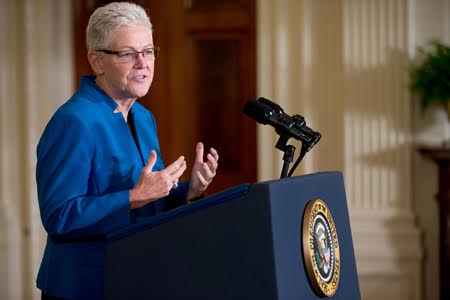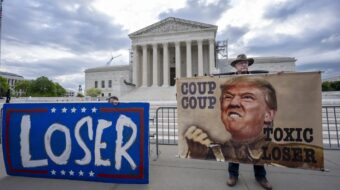
On Monday, the Environmental Protection Agency released its final rule on the regulation of power plants in an effort to curb greenhouse gas emissions by 33 percent (compared to 2005 levels) by 2030. In our nation’s first ever limits on carbon pollution, the EPA provides individual measures of success for which the 47 states (excluding Alaska, Hawaii, and Vermont) will craft their own action plans, “reflecting the inherent flexibility in the way the power system operates.”
The EPA crafted the state guidelines based on four “building blocks” they see as reasonably actionable: improved efficiency at existing plants, a preference for the use of natural gas over coal, requiring investment in renewables and reducing electricity use.
The third of those building blocks, requiring investment in renewables, is perhaps the most controversial. There is serious legal debate as to whether or not basing the carbon reduction goals on a plan that takes into account investment in renewable energy is constitutional. Critics argue that the EPA is overreaching by making states create broad “state plans” crafted by “a complex formula” as opposed to simply setting emission rates at existing plants. Supporters say that the plan allows enough flexibility for states to use any or all of these building blocks in its final road to reduction.
Cap-and-trade fallback measure
Like the Affordable Care Act that allowed states to set up their own healthcare exchanges in accordance with guidelines by a certain date or to take a Federal alternative, the EPA’s rule accounts for potential state abstinence.
In a separate document, it was highlighted that state governments who refuse to act in accordance with the new rule may face what, to them, will amount to a catch-22. A governor of a state who might benefit politically from resisting the new regulations opens the door to a potential primary challenger by being painted as the governor who allowed the EPA to institute cap-and-trade, a notorious buzzword on the right for what is an internationally common practice. According to the EPA, cap-and-trade is a free market-friendly carbon reduction option. The Federal governments cap-and-trade fallback measure would effectively allow them to bypass state obstruction and target energy producers directly in order to get emissions under control.
This aspect of the rule is not final and may undergo revisions in light of future state feedback.
“Stop putting polluters over people”
In the wake of the Obama administration’s most significant action on the environment yet, and with climate change no longer just a problem for future generations, polling results around this are firmly on the side of the President’s action.
In a recent Public Policy Polling poll of 8 swing states, 58 percent of respondents said they favored the clean power plan whereas 40 percent oppose it after hearing the arguments wielded by both sides. Considerable margins of voters in all 8 of the states surveyed consider climate change a “serious problem”: 77 percent of Democrats and 55 percent of independents, with 37 percent of Republicans.
When asked about potential Congressional obstruction from the likes of Mitch McConnell who recently urged states to ignore the EPA, the response was a definitive lack of support: 59 percent of those polled said states should follow the plan to develop their means of meeting new climate goals.
Not only is obstruction unpopular, but cooperation is popular (or at least harmless) with 63 percent of those polled saying they’d be more likely to support their member of Congress or that it would make no difference if they supported the EPA’s Clean Power Plan. Even 47 percent of Republicans responded that they would be more likely to support their congressperson or that it wouldn’t matter to them.
Brad Woodhouse, President of Americans United for Change said in a press conference on Thursday, “‘Republicans who say no to the President’s Clean Power Plan are saying no to the average American saving nearly $85 a year on their energy bill, no to preventing health impacts like asthma attacks, lung cancer, heart attacks other air pollution-related illnesses, no to preventing 3,600 premature deaths every year, and no to 250,000 new jobs. “
And yet Republican Attorneys General from 14 states are attempting to get the court to rehear their case against the rule even though it was thrown out by a Court of Appeals in the District of Columbia in June. In December, The New York Times broke the story on the connection between state attorneys and energy firm influence documenting the millions in campaign donations they’ve received.
At the same press conference, Christopher Hale, Executive Director of Catholics in Alliance for the Common Good, focused on the moral aspect of the fight saying that “care for creation is at the heart of the Christian and other faith traditions.” Citing a line from Pope Francis’ groundbreaking environmental encyclical, Hale warned, “God always forgives; we men sometimes forgive; but nature never forgives.”
Looking forward its clear that climate change will be a topic on the debate stage this election season. The new EPA rule has come out so close to the first Republican Presidential debate that it’s hard to imagine moderators ignoring it. The poll numbers have shown to be on the side of action, but which of the Republican candidates will break from big energy orthodoxy on the issue has yet to be seen.
Debbie Sease, National Campaign Director for the Sierra Club spoke with confidence when she said “These polls make one thing crystal clear: anyone who is serious about winning an election in these key states must be serious about supporting the Clean Power Plan.”
Photo: EPA Administrator Gina McCarthy speaks at the White House, Aug. 3, before President Obama spoke about his Clean Power Plan. The president is mandating even steeper greenhouse gas cuts from U.S. power plants than previously expected, while granting states more time and broader options to comply. | Andrew Harnik/AP












Comments